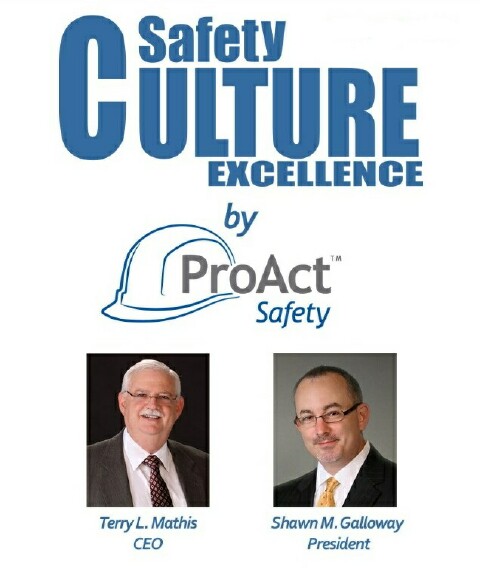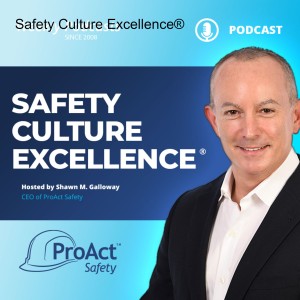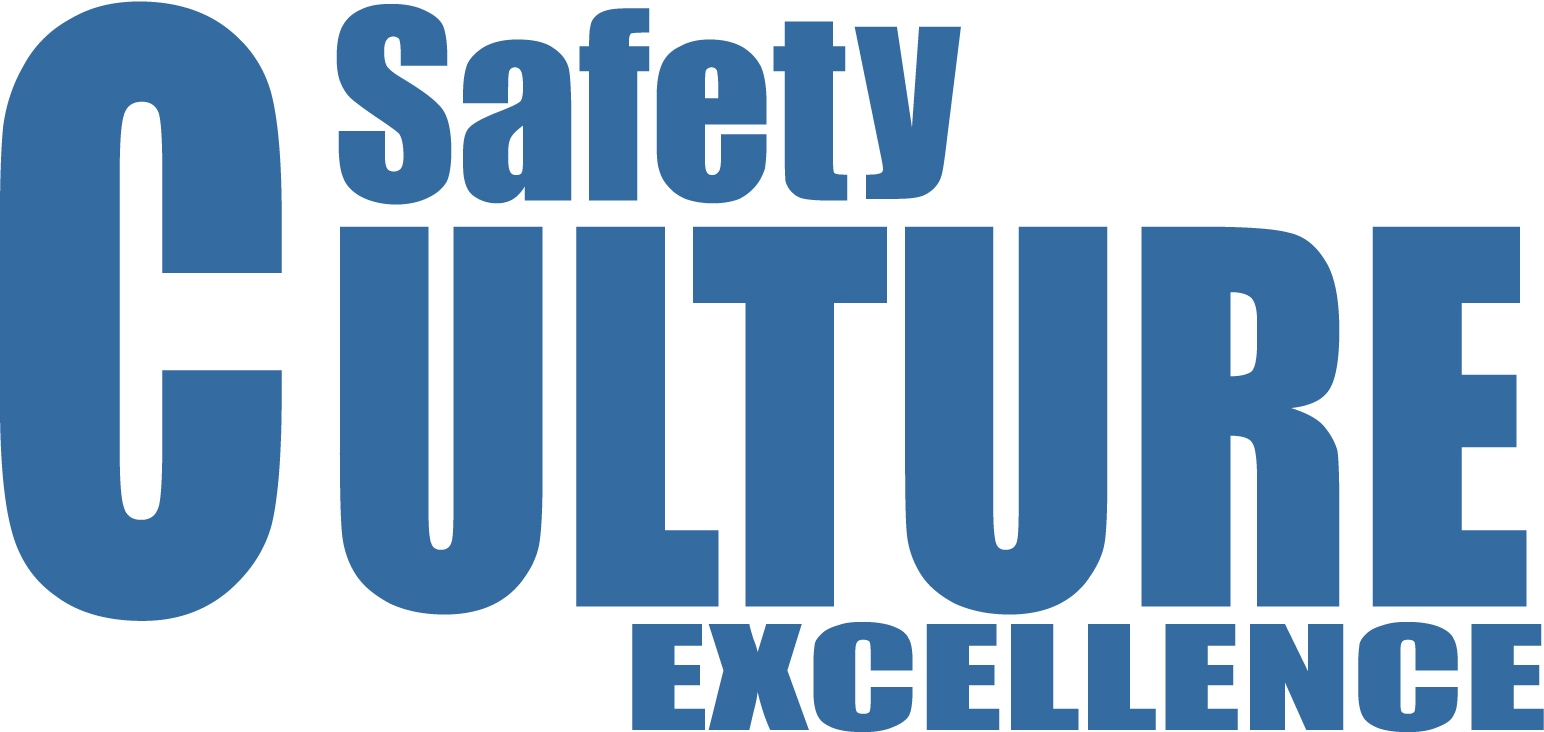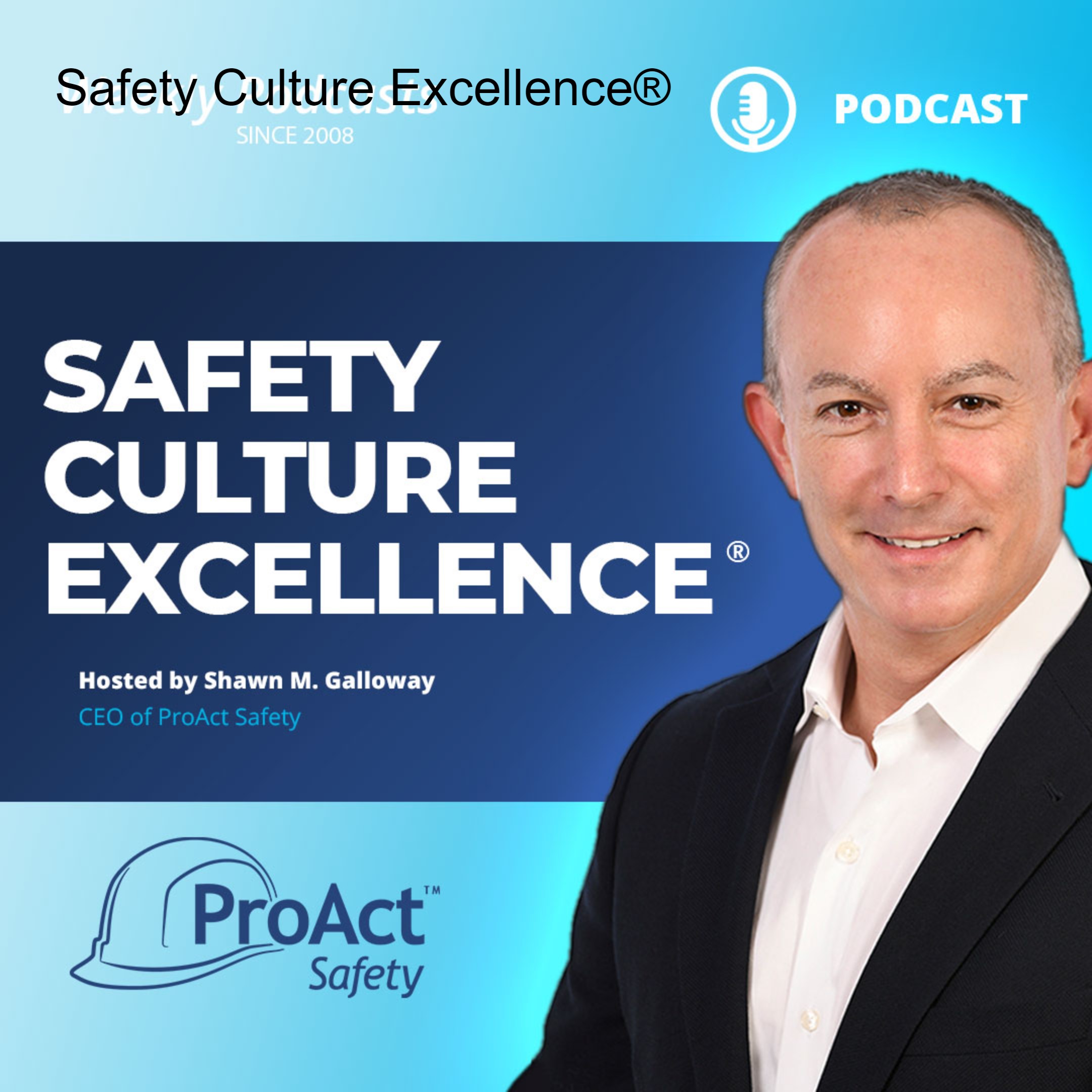Episodes

Monday Dec 16, 2013
320 - Three Strategies for Employee Engagement
Monday Dec 16, 2013
Monday Dec 16, 2013
Greetings everyone, this podcast recorded while in my home in TX. I’d like to share an article Terry Mathis wrote, published September 2013 in IndustryWeek Magazine. The published article can either be found on the magazine’s website or under Insights at www.ProActSafety.com.
I hope you enjoy the podcast this week. If you would like to download or play on demand our other podcasts, please visit the ProAct Safety’s podcast website at: http://www.safetycultureexcellence.com. If you would like access to archived podcasts (older than 90 days – dating back to January 2008) please visit www.ProActSafety.com/Store. For more detailed strategies to achieve and sustain excellence in performance and culture, pick up a copy of our book, STEPS to Safety Culture Excellence - http://proactsafety.com/insights/steps-to-safety-culture-excellence
Have a great week!
Shawn M. Galloway
ProAct Safety

Wednesday Dec 11, 2013
Showing Up: Step One of Safety Leadership
Wednesday Dec 11, 2013
Wednesday Dec 11, 2013
We have been told that the first step of doing any job is showing up. This is equally true of the job of leading safety. Leaders who are noticeably absent lose opportunities to effectively lead. Obviously leaders cannot be everywhere every time; but they can pick and choose key opportunities to emphasize the importance of safety with their presence.
When tragedies happen and leaders don’t show up, what is the message sent to the troops? When major new safety initiatives begin without the in-person support of key leaders, how official and important are they. When organizations have safety teams or committees which oversee safety efforts, how do they proceed when leaders fail to attend?
The physical presence of leaders must be accompanied by their involvement and attention as well. A worker commented recently, “There was a serious safety incident and none of the leaders got mad.” He reflected that at his last job leaders showed emotions when safety efforts didn’t go well and caused heated discussions and decisive actions. In short, he equated emotion with caring. Leaders show they care when they show up and participate. What they do in their offices and the boardroom will not have the necessary impact if they are not present and engaged at key happenings in the workplace. Leaders, start with step one.
-Terry L. Mathis
Terry L. Mathis is the founder and CEO of ProAct Safety, an international safety and performance excellence firm. He is known for his dynamic presentations in the fields of behavioral and cultural safety, leadership, and operational performance, and is a regular speaker at ASSE, NSC, and numerous company and industry conferences. EHS Today listed Terry as a Safety Guru in ‘The 50 People Who Most Influenced EHS in 2010, 2011 and 2012-2013. He has been a frequent contributor to industry magazines for over 15 years and is the coauthor of STEPS to Safety Culture Excellence, 2013, WILEY.

Monday Dec 09, 2013
319 - Consultants vs. Culture: Can the Two Work Against Each Other?
Monday Dec 09, 2013
Monday Dec 09, 2013
Greetings everyone, this podcast recorded while in Bend, OR. I’d like to share an article Terry Mathis wrote, published September 2013 in EHS Today Magazine. The published article can either be found on the magazine’s website or under Insights at www.ProActSafety.com.
I hope you enjoy the podcast this week. If you would like to download or play on demand our other podcasts, please visit the ProAct Safety’s podcast website at: http://www.safetycultureexcellence.com. If you would like access to archived podcasts (older than 90 days – dating back to January 2008) please visit www.ProActSafety.com/Store. For more detailed strategies to achieve and sustain excellence in performance and culture, pick up a copy of our book, STEPS to Safety Culture Excellence - http://proactsafety.com/insights/steps-to-safety-culture-excellence
Have a great week!
Shawn M. Galloway
ProAct Safety

Wednesday Dec 04, 2013
Injuries Aren’t the Only Kind of Accidents
Wednesday Dec 04, 2013
Wednesday Dec 04, 2013
When you think about the title of this piece, the first thing that comes to most people’s minds is an accident that produced property damage but no injuries. While that is a common example of this principle, it is not the only one. Virtually any undesired, unplanned, unexpected result of a work process is accidental. It could be argued that anything that did not turn out as planned is an accident.
When you think about it this way, people invest in the wrong stocks, elect the wrong people to office, and marry the wrong spouses from time to time. We don’t blame such accidents exclusively on the stock market, the government, or dating services. Likewise when an organization has a rash of injuries, it might not be exclusively the fault of the safety programs and specialists.
The real key to understanding and applying this principle is simply that good management must anticipate the multiple ways that processes can produce unwanted results and prevent them from doing so. When you think this way, safety is not a touchy, feely specialty to be delegated. It is a principle of good management.
Managers must constantly be on guard against the ways in which their processes can fail or go awry. Such events can be caused by people, machines, conditions, process flaws or combinations of these. Designing and constantly improving all the aspects of business processes is the job of leaders, managers and supervisors. Blaming workers or delegating problem areas seldom creates organizational excellence. It is crucial to remember that when the goose quits laying golden eggs, you need better goose management: not an egg specialists.
-Terry L. Mathis
Terry L. Mathis is the founder and CEO of ProAct Safety, an international safety and performance excellence firm. He is known for his dynamic presentations in the fields of behavioral and cultural safety, leadership, and operational performance, and is a regular speaker at ASSE, NSC, and numerous company and industry conferences. EHS Today listed Terry as a Safety Guru in ‘The 50 People Who Most Influenced EHS in 2010, 2011 and 2012-2013. He has been a frequent contributor to industry magazines for over 15 years and is the coauthor of STEPS to Safety Culture Excellence, 2013, WILEY.

Monday Dec 02, 2013
318 - Safety Strategy: What Great Leaders Do Well
Monday Dec 02, 2013
Monday Dec 02, 2013
Greetings everyone, this podcast recorded while in Cotulla, TX. I’d like to share an article I wrote, published November 2013 in OHS Magazine. The published article can either be found on the magazine’s website or under Insights at www.ProActSafety.com.
I hope you enjoy the podcast this week. If you would like to download or play on demand our other podcasts, please visit the ProAct Safety’s podcast website at: http://www.safetycultureexcellence.com. If you would like access to archived podcasts (older than 90 days – dating back to January 2008) please visit www.ProActSafety.com/Store. For more detailed strategies to achieve and sustain excellence in performance and culture, pick up a copy of our book, STEPS to Safety Culture Excellence - http://proactsafety.com/insights/steps-to-safety-culture-excellence
Have a great week!
Shawn M. Galloway
ProAct Safety

Wednesday Nov 27, 2013
Leading vs. Lagging Indicators in Safety
Wednesday Nov 27, 2013
Wednesday Nov 27, 2013
As more and more leaders and safety professionals realize the limitations of reactive safety, they search for leading indicators to help them manage safety more proactively. This thinking fueled the concept that lagging indicators alone, are not truly representative of safety performance, nor are they predictive or prescriptive.
The first round of so-called “leading indicators” was little more than a measurement of safety-related activities: hours of safety training, attendance at safety meetings, participation in safety programs, etc. OSHA’s crackdown on incentives that could potentially suppress reporting of accidents drove many organizations to base their incentives on these activity metrics rather than simply not having an accident.
When behavior-based safety became the rage, the measurement of behaviors from observations came to be thought of as a leading indicator. As safety culture became a buzz phrase, perception surveys gained in popularity and came to be considered another potential leading indicator. The search for meaningful leading indicators goes on because no one of these has proven adequate in predicting and preventing injuries.
Where none of these alone succeed, all of them together potentially can. A balanced-scorecard approach in which the metrics not only complement, but predict each other has proven quite effective in proactively predicting how to prevent accidents. When you measure how much activity it takes to change perceptions, how much of a change in perceptions it takes to change behaviors, and how much behavior change it takes to change the lagging indicators, you begin to truly measure the effectiveness of safety efforts. Just as balanced scorecards have revolutionized strategic management, with our most successful clients, balanced scorecards for safety have proven to have a transformational impact on safety management. How balanced are your measurements?
-Terry L. Mathis
Terry L. Mathis is the founder and CEO of ProAct Safety, an international safety and performance excellence firm. He is known for his dynamic presentations in the fields of behavioral and cultural safety, leadership, and operational performance, and is a regular speaker at ASSE, NSC, and numerous company and industry conferences. EHS Today listed Terry as a Safety Guru in ‘The 50 People Who Most Influenced EHS in 2010, 2011 and 2012-2013. He has been a frequent contributor to industry magazines for over 15 years and is the coauthor of STEPS to Safety Culture Excellence, 2013, WILEY.

Monday Nov 18, 2013
316 - Mergers and Acquisitions: Aligning Your Next Culture
Monday Nov 18, 2013
Monday Nov 18, 2013
Greetings everyone, this podcast recorded while in Craig, CO. I’d like to share an article I wrote, published September 2013 in BIC Magazine. The published article can either be found on the magazine’s website or under Insights at www.ProActSafety.com.
I hope you enjoy the podcast this week. If you would like to download or play on demand our other podcasts, please visit the ProAct Safety’s podcast website at: http://www.safetycultureexcellence.com. If you would like access to archived podcasts (older than 90 days – dating back to January 2008) please visit www.ProActSafety.com/Store. For more detailed strategies to achieve and sustain excellence in performance and culture, pick up a copy of our book, STEPS to Safety Culture Excellence - http://proactsafety.com/insights/steps-to-safety-culture-excellence
Have a great week!
Shawn M. Galloway
ProAct Safety

Wednesday Nov 13, 2013
Focus and Scan
Wednesday Nov 13, 2013
Wednesday Nov 13, 2013
When you drive down the highway your eyes perform two distinct, but related functions. You look at the entire roadway in front of you (scan) and you often glance at the stripes that line your position on the highway (focus). Both of these functions are crucial to safe driving. You need to know the entire path you are traveling, but also need to stay within your land to avoid other vehicles.
Most safety programs have a scan but lack a focus. Workers are admonished to “be careful” and “think before you act” but are not focused on specific improvement targets. Safety improvement is an elephant that must be eaten a bite at a time. Scanning may maintain the status quo, but it will not lead to significant improvement.
The best-performing organizations in safety constantly target specific improvements while maintaining the emphasis on the big picture. Workers are careful but also focused on specific improvement targets that can be transformational for the organization. Safety cultures form around their ability to solve safety problems and move on to other targets. They become a “can do” culture and thrive on conquering specific safety challenges. Excellence is not one-dimensional. It is a combination of scanning for all risks while focusing on overcoming specific risks. The journey to safety excellence is taken a step at a time and these steps are the focus that complement the scanning of the road ahead.
-Terry L. Mathis
Terry L. Mathis is the founder and CEO of ProAct Safety, an international safety and performance excellence firm. He is known for his dynamic presentations in the fields of behavioral and cultural safety, leadership, and operational performance, and is a regular speaker at ASSE, NSC, and numerous company and industry conferences. EHS Today listed Terry as a Safety Guru in ‘The 50 People Who Most Influenced EHS in 2010, 2011 and 2012-2013. He has been a frequent contributor to industry magazines for over 15 years and is the coauthor of STEPS to Safety Culture Excellence, 2013, WILEY.

Wednesday Nov 06, 2013
The Danger of Compliance
Wednesday Nov 06, 2013
Wednesday Nov 06, 2013
The goal of many safety programs is to get all workers and the workplace into compliance with applicable rules and regulations. This is a necessary and foundational step in any effective safety effort. However, if the goals and progression stop at compliance, this can cause crucial problems for the future. Once the workplace passes muster and workers know and adhere to the rules, then what? The next steps in safety must take the organization beyond the performance levels achieved through compliance. These steps require much more of workers than simply following the rules.
Beyond compliance is excellence through safety culture. An excellent safety culture is one in which workers are engaged, not simply conforming. Worker engagement in safety is seldom accomplished with the tools of compliance. A new set of tools that challenges workers to belong, participate, and expend creative energy is needed. The tools of compliance cannot be used or even adapted to meet these challenges. In fact, the tools used by many organizations to accomplish compliance can actually hamper or kill employee engagement. A work force can be policed into compliance but must be coached into excellence.
Failure to change from safety cops to safety coaches can stop the progression of safety performance in its tracks. Workers will develop a “good enough” attitude toward safety if there is no reason to go above and beyond. They will not buy in if there is no compelling rationale. They will not feel part of the effort if there are no involvement opportunities. They will never own the safety-excellence effort if they are not allowed to help create it. Recognizing the point at which compliance needs to give way to excellence is the key to continuous improvement in safety.
-Terry L. Mathis
Terry L. Mathis is the founder and CEO of ProAct Safety, an international safety and performance excellence firm. He is known for his dynamic presentations in the fields of behavioral and cultural safety, leadership, and operational performance, and is a regular speaker at ASSE, NSC, and numerous company and industry conferences. EHS Today listed Terry as a Safety Guru in ‘The 50 People Who Most Influenced EHS in 2010, 2011 and 2012-2013. He has been a frequent contributor to industry magazines for over 15 years and is the coauthor of STEPS to Safety Culture Excellence, 2013, WILEY.

Monday Nov 04, 2013
314 - Competitive Safety: Breaking the Mold
Monday Nov 04, 2013
Monday Nov 04, 2013
Greetings everyone, this podcast recorded while in Austin, TX. I’d like to share an article written by Terry L. Mathis, published August 2013 in EHS Today Magazine. The published article can either be found on the magazine’s website or under Insights at www.ProActSafety.com.
I hope you enjoy the podcast this week. If you would like to download or play on demand our other podcasts, please visit the ProAct Safety’s podcast website at: http://www.safetycultureexcellence.com. If you would like access to archived podcasts (older than 90 days – dating back to January 2008) please visit www.ProActSafety.com/Store. For more detailed strategies to achieve and sustain excellence in performance and culture, pick up a copy of our book, STEPS to Safety Culture Excellence - http://proactsafety.com/insights/steps-to-safety-culture-excellence
Have a great week!
Shawn M. Galloway
ProAct Safety

